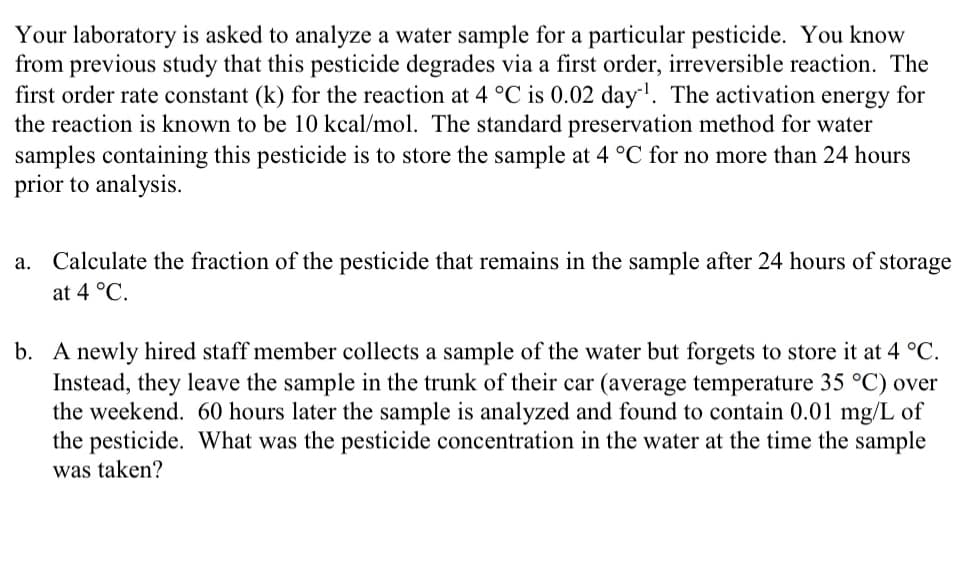Your laboratory is asked to analyze a water sample for a particular pesticide. You know from previous study that this pesticide degrades via a first order, irreversible reaction. The first order rate constant (k) for the reaction at 4 °C is 0.02 day. The activation energy for the reaction is known to be 10 kcal/mol. The standard preservation method for water samples containing this pesticide is to store the sample at 4 °C for no more than 24 hours prior to analysis. a. Calculate the fraction of the pesticide that remains in the sample after 24 hours of storage at 4 °C. b. A newly hired staff member collects a sample of the water but forgets to store it at 4 °C. Instead, they leave the sample in the trunk of their car (average temperature 35 °C) over the weekend. 60 hours later the sample is analyzed and found to contain 0.01 mg/L of the pesticide. What was the pesticide concentration in the water at the time the sample was taken?
Your laboratory is asked to analyze a water sample for a particular pesticide. You know from previous study that this pesticide degrades via a first order, irreversible reaction. The first order rate constant (k) for the reaction at 4 °C is 0.02 day. The activation energy for the reaction is known to be 10 kcal/mol. The standard preservation method for water samples containing this pesticide is to store the sample at 4 °C for no more than 24 hours prior to analysis. a. Calculate the fraction of the pesticide that remains in the sample after 24 hours of storage at 4 °C. b. A newly hired staff member collects a sample of the water but forgets to store it at 4 °C. Instead, they leave the sample in the trunk of their car (average temperature 35 °C) over the weekend. 60 hours later the sample is analyzed and found to contain 0.01 mg/L of the pesticide. What was the pesticide concentration in the water at the time the sample was taken?
Chemistry: The Molecular Science
5th Edition
ISBN:9781285199047
Author:John W. Moore, Conrad L. Stanitski
Publisher:John W. Moore, Conrad L. Stanitski
Chapter11: Chemical Kinetics: Rates Of Reactions
Section: Chapter Questions
Problem 11.ACP: (Section 11-5) A rule of thumb is that for a typical reaction, if concentrations are unchanged, a...
Related questions
Question

Transcribed Image Text:Your laboratory is asked to analyze a water sample for a particular pesticide. You know
from previous study that this pesticide degrades via a first order, irreversible reaction. The
first order rate constant (k) for the reaction at 4 °C is 0.02 day¹. The activation energy for
the reaction is known to be 10 kcal/mol. The standard preservation method for water
samples containing this pesticide is to store the sample at 4 °C for no more than 24 hours
prior to analysis.
Calculate the fraction of the pesticide that remains in the sample after 24 hours of storage
at 4 °C.
b. A newly hired staff member collects a sample of the water but forgets to store it at 4 °C.
Instead, they leave the sample in the trunk of their car (average temperature 35 °C) over
the weekend. 60 hours later the sample is analyzed and found to contain 0.01 mg/L of
the pesticide. What was the pesticide concentration in the water at the time the sample
was taken?
Expert Solution
This question has been solved!
Explore an expertly crafted, step-by-step solution for a thorough understanding of key concepts.
This is a popular solution!
Trending now
This is a popular solution!
Step by step
Solved in 2 steps with 2 images

Knowledge Booster
Learn more about
Need a deep-dive on the concept behind this application? Look no further. Learn more about this topic, chemistry and related others by exploring similar questions and additional content below.Recommended textbooks for you

Chemistry: The Molecular Science
Chemistry
ISBN:
9781285199047
Author:
John W. Moore, Conrad L. Stanitski
Publisher:
Cengage Learning

Chemistry: Principles and Practice
Chemistry
ISBN:
9780534420123
Author:
Daniel L. Reger, Scott R. Goode, David W. Ball, Edward Mercer
Publisher:
Cengage Learning

Chemistry: Principles and Reactions
Chemistry
ISBN:
9781305079373
Author:
William L. Masterton, Cecile N. Hurley
Publisher:
Cengage Learning

Chemistry: The Molecular Science
Chemistry
ISBN:
9781285199047
Author:
John W. Moore, Conrad L. Stanitski
Publisher:
Cengage Learning

Chemistry: Principles and Practice
Chemistry
ISBN:
9780534420123
Author:
Daniel L. Reger, Scott R. Goode, David W. Ball, Edward Mercer
Publisher:
Cengage Learning

Chemistry: Principles and Reactions
Chemistry
ISBN:
9781305079373
Author:
William L. Masterton, Cecile N. Hurley
Publisher:
Cengage Learning

Chemistry for Engineering Students
Chemistry
ISBN:
9781337398909
Author:
Lawrence S. Brown, Tom Holme
Publisher:
Cengage Learning

Chemistry by OpenStax (2015-05-04)
Chemistry
ISBN:
9781938168390
Author:
Klaus Theopold, Richard H Langley, Paul Flowers, William R. Robinson, Mark Blaser
Publisher:
OpenStax

Chemistry
Chemistry
ISBN:
9781305957404
Author:
Steven S. Zumdahl, Susan A. Zumdahl, Donald J. DeCoste
Publisher:
Cengage Learning